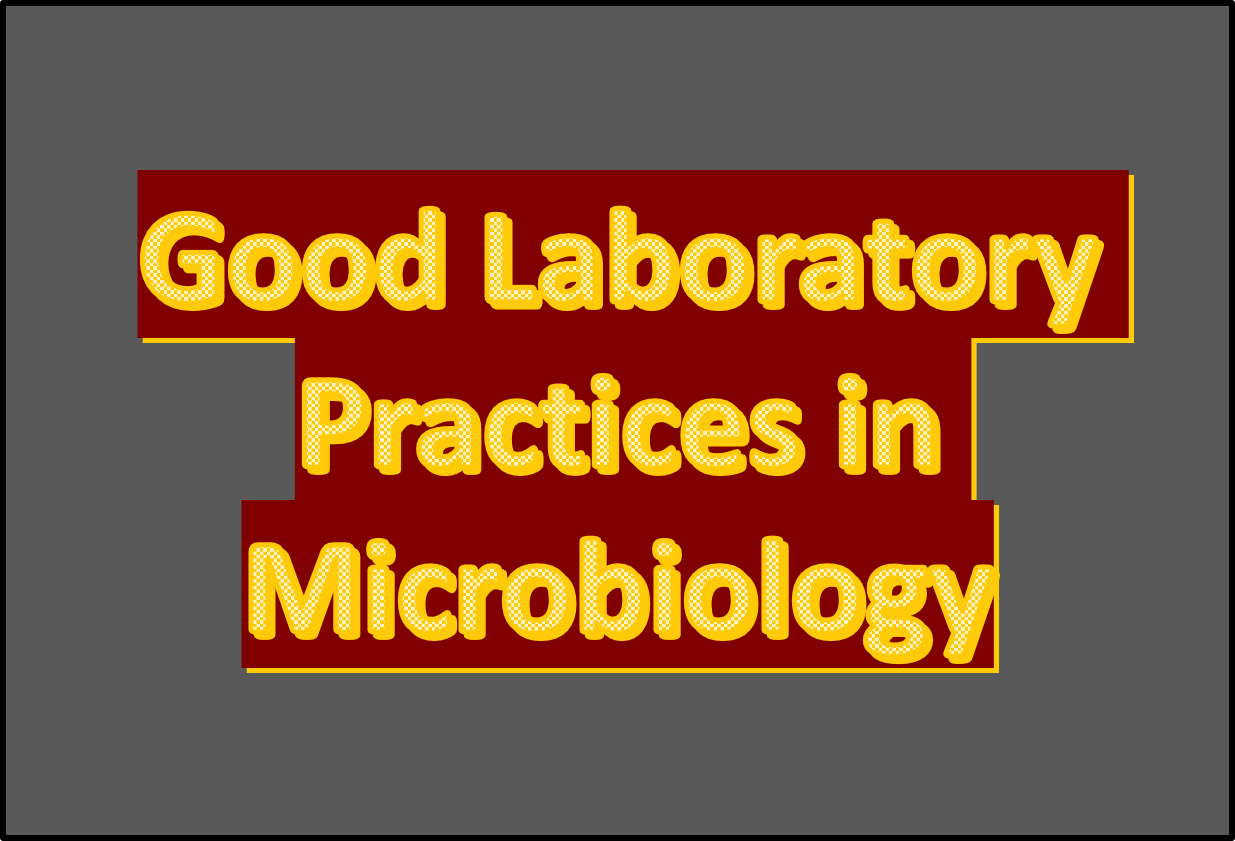SOP for Good Laboratory Practices in Microbiology

Good laboratory practices in microbiology
This article describes about (Standard Operating procedure) SOP for Good Laboratory Practices in Microbiology.
SOP for Good Laboratory Practices in Microbiology
I. Purpose & Scope:
- To provide a general instructions to be followed while working in the Microbiology Laboratory of pharmaceutical industry
- Applicable to all personnel who are working in Microbiology laboratory.
II. Responsibilities:
- All microbiology and related personnel shall be responsible to follow and implement this SOP.
III. Premises and utilities :
- Maintain the laboratory and its premises clean and tidy.
- Microbiology department personnel should avoid mix-ups and cross contamination during analysis.
- The disposable gowns shall be disposed after usage in separate used garment bin.
- Keep work benches of laboratories clean and tidy all the time.
- Keep the samples, standards, laboratory reagent, apparatus, accessories and records at adequate and suitable storage space.
IV.SAFETY :
- Safety in laboratories is an individual, as well as management responsibility; however it is the laboratory staff’s responsibility to follow the safe work practices.
- Never adopt a casual attitude in the laboratory and always be conscious of potential hazards.
- Never treat irresponsible behavior in the laboratory.
- Do not consume food or drink in the laboratory.
- Clean up all spills immediately.
- Dispose of specialized wastes (e.g. broken glassware, biological material) in containers reserved for this particular type of waste.
- Conduct safety inspections of the laboratory to determine unsafe practices or situations.
- Do not lift heavy objects without aid from an additional person or lifting aid.
- All personnel must be acquainted with the location of safety equipment and emergency procedures in case of fire, explosion etc.
- Hands and fingernails must be thoroughly washed after each job and before moving to areas outside the laboratory such as the canteen or toilets.
- Laboratory gowns must be changed in a dedicated area before going outside the lab.
- Long hair may constitute both a fire risk and risk of contamination; therefore it must be tied back with a hair band & should remain completely covered in the cap.
- All injuries must be reported immediately to the Admin department.
- Minor cuts and abrasions can provide route for infection, therefore will be reported to the Admin department and should be adequately
- Always identify the location of emergency exit in the laboratory for exit during emergency.
V. Apparel :
- Protective clothing in the form of laboratory apron must be worn at all times within the laboratory.
- Wear dedicated foot wears within the working areas only.
- Appropriate safety goggles and gloves should be worn.
- Laboratory personnel should present a clean and tidy appearance at all times.
- Laboratory apron should be removed before leaving the laboratory.
- Hands must be disinfected with an antiseptic skin cleanser before leaving the laboratory.
VI. Work practices :
- All microbial samples should be regarded as hazardous.
- Leaking containers should be disinfected, decontaminated and discarded. All cultures should be clearly identified with proper labeling, dated and appropriately stored.
- During work, care should be taken to minimize the production of aerosols.
- All fungal cultures must be handled with care. Fungi should be recognized as potential pathogens or producers of mycotoxins which may be lethal or carcinogenic. Because airborne fungal spores can spread in a similar manner to aerosols, plate cultures shall be handled with at most care.
- Care must be taken when flaming a wire loop, by drawing the loop gradually through the flame from the handle end to the loop.
- Mouth pipetting is prohibited.
- Bench surfaces must be decontaminated with disinfectant solution. It is imperative that the work area is decontaminated before work begins and after the work is completed. Only one function at a given time can be conducted on the same bench. e.g. Do not carry out streaking of plates at the same time and on the same bench as where samples are being set up.
- Ensure that all contaminated waste is secured to avoid spillage.
- All contaminated liquids and laboratory equipment must be decontaminated before disposal.
- Contaminated re-usable glass wares/materials must be decontaminated and thoroughly washed.
- Used tips of Micropipette, must be placed in approved disinfectant solution (2.5%Dettol/ 2.5% Savlon or 70%IPA) to minimize the production of aerosols.
- Laboratory doors must be closed when work is in progress.
- Always wash hands thoroughly with antiseptic soap / liquid after handling the cultures.
- Wear hand gloves when handling stains or reagents.
- For MLT (Microbial limit test) analysis of Tablet and Capsule, defined quantity of product (Generally 10 grams) to be added in defined media, under laminar air flow. Quantity of product to be added is decided on the basis of average weight of product.
- For MLT (Microbial limit test) analysis of Ointment, defined quantity of product (Generally 10 grams) to be taken in sterilized bottle on weighing balance. After weighing the sample, it should be transfer to MLT room and required sterile medium shall be added to it, under laminar air flow.
- In case of capsules or creams if sample not get dissolved, prepared dilution of sample solution should be kept in incubator at 40 to 45°C for approximate 30 minutes, for heating the solution to prepare homogenized sample solution.
- All the culture related activities shall be performed in ‘Culture Handling Room’.
- Preferably do analysis of samples prior to culture handling activities.
VII. Treatment of laboratory spills:
- Avoid breathing the aerosol.
- Allow the aerosol to settle.
- Remove laboratory apron and/or footwear suspected of being contaminated, place it in a separate bag.
- Wash hands with an antiseptic cleanser.
- Wear the protective clothing (e.g. rubber gloves).
- Pour the disinfectant solution around the spill allowing it to mix gradually with the contaminated material. Do not pour disinfectant directly onto the spill, as this can produce more aerosols.
- Lay tissue paper, wetted with disinfectant, over the spill & allow 15 to 30 minutes (depending on cultures spilled) for effective disinfection.
- Wipe over the surrounding area with disinfectant.
- Carefully mop up the spillage and transfer all contaminated objects and liquid to separate bag.
- Ensure that hands are thoroughly washed with antiseptic soap / liquid after dealing with a spill or after touching contaminated material.
VIII. Waste disposal:
- Laboratory waste shall be collected in segregated containers.
- Containers containing biological hazard waste must be labeled as such.
- Sharp objects should be collected in a rigid, puncture-proof container.
- Non-infectious material such as waste paper, plastic and paper products should be collected in a single layer garbage bag.
- Infectious material such as media, cultures, petri dishes, culture bottles, must be collected SS Container and then decontaminated by autoclaving prior to disposal.
IX. Treatment of wastes:
- All infectious material, used media, used plates must be decontaminated by autoclaving at 121.6°C for 30 minutes.
- Monitor the efficacy of the sterilization cycle by including biological indicator (Geobacillus stearothermophilius) once three months. Routinely monitor each cycle.
- Once the material has been decontaminated, dispose off in sink connected to ETP plant.
X. Laboratory cleaning:
- Work areas should be free from objects not relevant to the work being undertaken.
- Work benches must be decontaminated before work commences and after the work has been completed.
- Benches and work surfaces must be cleared at the end of each working day and then disinfected.
- Open shelves, equipment and reagent bottles should be cleaned.
- Perform the Laboratory Cleaning and Sanitizing procedure as per specified SOP.
XI. Laboratory Equipment’s :
- All laboratory equipment must be kept clean and be well maintained throughout its life.
- If a piece of equipment is found to be out of specification, a “Do Not Use” sticker must be placed on the equipment and senior staff must be notified.
- Arrangements must be put in to place for the equipment to be recalibrated either through the engineering department or through an approved external source depending on where it is normally serviced. The equipment must not be used until it is found to be within specification. The sticker can then be removed.
a) Thermometers and Digital hygrometer :
- Thermometers and digital hygrometer will be calibrated yearly by external agency. Monitor and record the temperature and relative humidity of area twice in day.
b) Incubators:
- Monitor and record the temperature of incubators twice in day. Using dry lint free cloth wipes the both inner and outer doors on daily basis. Calibration of incubators shall be done once in year by temperature mapping.
c) pH meter:
- Calibrate the pH meter using standard buffer solutions of pH 4.00, and 9.18 prior to use. Record the reading in approved format.
d) Balance:
- Calibrate once a year by contract laboratory. Verification of balance shall be done by using standard weights daily prior to use. Record results in approved format.
e) Autoclaves:
- Sterilization performance shall be checked once in a three months with
- Biological indicators. Sterilization parameters, temperature and time shall be recorded for each load in sterilization record. Validation of autoclave shall be done once in a year.
f) Laminar Air Flow unit:
- The Laminar Air Flow clean air work stations are intended to maintain a sterile work area essentially free of particulate contaminants in a microbiological testing laboratory. The laminar air flow unit must be checked and certified yearly for performance and compliance to ISO-14544-1 to confirm cleanliness class area.
g) Hot air oven :
- Keep the washed glassware’s for drying purpose at desired (60°C) temperature. Calibration of instrument shall be done once in year.
h) Refrigerator :
- All culture slants, culture dilutions, test kit, shall be kept at 2°C to 8°C.
- Monitor and record the temperature of refrigerator twice in day. Calibration of refrigerator shall be performed once in year.
XII) Validation Protocol :
- Prepare the ‘Microbiological validation protocol’ for each type of study or instrument validation.
- Give the protocol number to each validation protocol.
- Protocol Numbing system shall be as given


